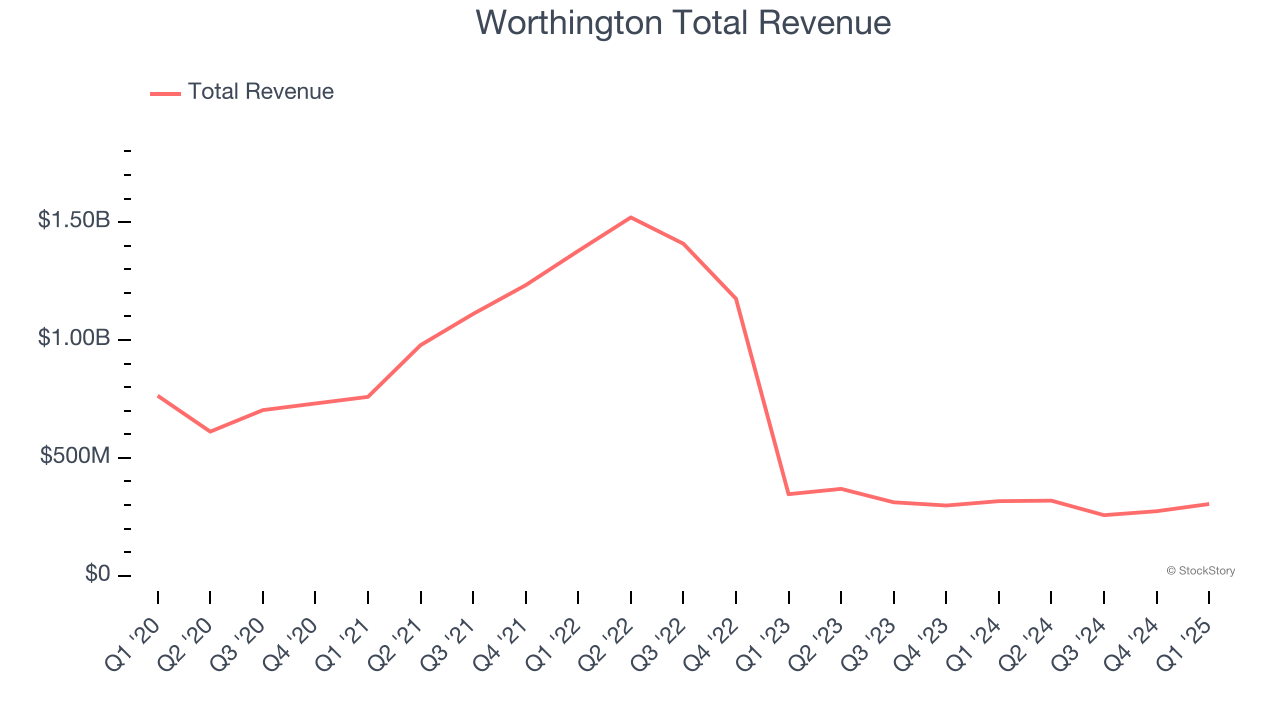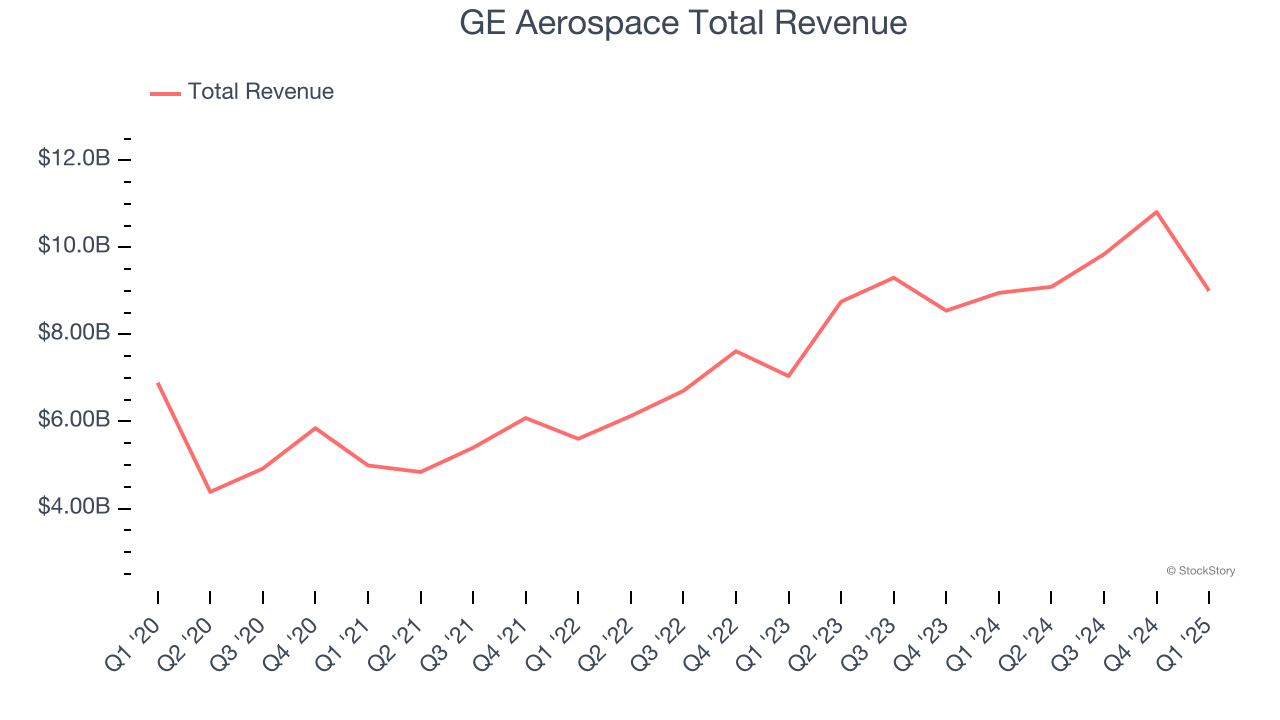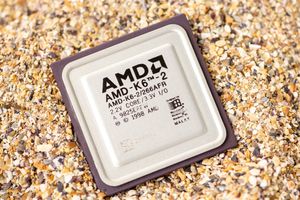
As the Q1 earnings season comes to a close, it’s time to take stock of this quarter’s best and worst performers in the industrial machinery industry, including Worthington (NYSE: WOR) and its peers.
Automation that increases efficiency and connected equipment that collects analyzable data have been trending, generating new demand for industrial machinery and components. Companies that innovate and create digitized solutions can spur sales and speed up replacement cycles while those resting on their laurels can see dwindling market positions. Like the broader industrials sector, industrial machinery and components companies are also at the whim of economic cycles. Consumer spending and interest rates, for example, can greatly impact the industrial production that drives demand for these companies’ offerings.
The 8 industrial machinery stocks we track reported a mixed Q1. As a group, revenues were in line with analysts’ consensus estimates.
In light of this news, share prices of the companies have held steady as they are up 4.4% on average since the latest earnings results.
Best Q1: Worthington (NYSE: WOR)
Founded by a steel salesman, Worthington (NYSE: WOR) specializes in steel processing, pressure cylinders, and engineered cabs for commercial markets.
Worthington reported revenues of $304.5 million, down 3.9% year on year. This print exceeded analysts’ expectations by 6.7%. Overall, it was a very strong quarter for the company with an impressive beat of analysts’ EPS estimates and a solid beat of analysts’ adjusted operating income estimates.
"We delivered strong results in Q3, achieving year-over-year and sequential growth in revenue, adjusted EBITDA and adjusted EPS," said Worthington Enterprises President and CEO Joe Hayek.

Worthington pulled off the biggest analyst estimates beat but had the slowest revenue growth of the whole group. Unsurprisingly, the stock is up 18% since reporting and currently trades at $49.11.
Is now the time to buy Worthington? Access our full analysis of the earnings results here, it’s free.
GE Aerospace (NYSE: GE)
One of the original 12 companies on the Dow Jones Industrial Average, General Electric (NYSE: GE) is a multinational conglomerate providing technologies for various sectors including aviation, power, renewable energy, and healthcare.
GE Aerospace reported revenues of $9.00 billion, flat year on year, falling short of analysts’ expectations by 7.9%. However, the business still had a satisfactory quarter with a solid beat of analysts’ EBITDA estimates but full-year EPS guidance missing analysts’ expectations.

The market seems happy with the results as the stock is up 11.3% since reporting. It currently trades at $198.40.
Is now the time to buy GE Aerospace? Access our full analysis of the earnings results here, it’s free.
Weakest Q1: Snap-on (NYSE: SNA)
Founded in 1920, Snap-on (NYSE: SNA) is a global provider of tools, equipment, and diagnostics for various industries such as vehicle repair, aerospace, and the military.
Snap-on reported revenues of $1.24 billion, down 3% year on year, falling short of analysts’ expectations by 4.1%. It was a disappointing quarter as it posted a significant miss of analysts’ adjusted operating income estimates.
As expected, the stock is down 7.4% since the results and currently trades at $307.50.
Read our full analysis of Snap-on’s results here.
Dover (NYSE: DOV)
A company that manufactured critical equipment for the United States military during World War II, Dover (NYSE: DOV) manufactures engineered components and specialized equipment for numerous industries.
Dover reported revenues of $1.87 billion, flat year on year. This print lagged analysts' expectations by 0.7%. It was a slower quarter as it also recorded a significant miss of analysts’ adjusted operating income estimates.
The stock is up 1.3% since reporting and currently trades at $168.51.
Read our full, actionable report on Dover here, it’s free.
Otis (NYSE: OTIS)
Credited with inventing the first hydraulic passenger elevator, Otis Worldwide (NYSE: OTIS) is an elevator and escalator manufacturing, installation and service company.
Otis reported revenues of $3.35 billion, down 2.5% year on year. This result was in line with analysts’ expectations. However, it was a slower quarter as it recorded a miss of analysts’ organic revenue and EBITDA estimates.
The stock is down 5.6% since reporting and currently trades at $93.30.
Read our full, actionable report on Otis here, it’s free.
Market Update
As a result of the Fed’s rate hikes in 2022 and 2023, inflation has come down from frothy levels post-pandemic. The general rise in the price of goods and services is trending towards the Fed’s 2% goal as of late, which is good news. The higher rates that fought inflation also didn't slow economic activity enough to catalyze a recession. So far, soft landing. This, combined with recent rate cuts (half a percent in September 2024 and a quarter percent in November 2024) have led to strong stock market performance in 2024. The icing on the cake for 2024 returns was Donald Trump’s victory in the U.S. Presidential Election in early November, sending major indices to all-time highs in the week following the election. Still, debates around the health of the economy and the impact of potential tariffs and corporate tax cuts remain, leaving much uncertainty around 2025.
Want to invest in winners with rock-solid fundamentals? Check out our Hidden Gem Stocks and add them to your watchlist. These companies are poised for growth regardless of the political or macroeconomic climate.
Join Paid Stock Investor Research
Help us make StockStory more helpful to investors like yourself. Join our paid user research session and receive a $50 Amazon gift card for your opinions. Sign up here.






